With Google looking in ever more sophisticated ways to promote sites with relevant, valuable and engaging, blog content becomes a primary asset for SEO success.
The current SEO evaluation system is all about meaningful and consistent communication, so putting good effort in crafting content that can catch people’s attention is as important as simply optimising landing pages for search.
When done with a thoughtful approach and constancy it is likely to pay off in the long run. We all know this, of course.
A blog section is the part of your site which is most fresh and alive, where you can easily tailor content to keywords, engage your audience and interact with the wider web.
In other words, this is where you can rank for long tail keywords, get shares and likes or attract links.
Keywords which blogposts can rank for are particularly interesting for SEO. These informational searches set a live testing environment to understand your user persona, aside from what you can learn from other search, marketing or demographic data.
Whether it is content marketing that has become an SEO discipline, or SEO a content marketing exercise, we are in fact noticing these will increasingly have the same tools, objectives and goals.
This is the latest trend in many digital marketing areas, after all.
So, we are saying blog content is important.
However, a good blog is not only the result of a very creative spirit or a wild imagination. To be effective for search, it needs to be laid out with a methodical SEO approach, where the concern for the infrastructure is as important as that for the actual content.
In this article, we are going to take a closer look at how to structure a blog through its categories and tags.
[Case Study] Driving growth in new markets with on-page SEO
First things first, you may ask:
What is the difference between blog categories and tags?
The categories of a blog serve users to navigate content. Thanks to these, one can more easily browse posts and retrieve older articles without having to follow a merely chronological sequence.
Blog categories therefore have a very functional purpose. But they are also highly significant. This is to say these labels will suggest, to users and search engines, the main topics and themes of the blog.
Basically, categories are like topic containers, organising the blog into a vertical linking structure, with individual articles placed below the different categories. Tags also serve as a clustering tool for articles with similar theme across different categories. These, on the other hand, will create additional linking on a horizontal level.
Just like blog categories, tags are also important labels, effectively signaling the semantic proximity of content and serving as an auxiliary navigation.
So, if both tags and categories have a similar nature as an organisational framework, what is the actual difference when considering this kind of pages?
Here are some general aspects which suggest a different function for the two:
- Blog categories define broader topics whereas tags are likely to specify more concise topics.
- Unlike tags, blog categories can be hierarchical; meaning you can create sub-categories below categories.
- Blog categories are generally used as a primary navigation whereas tag pages offer cross-linking for internal navigation.
- Generally, a blogpost is placed within a single category but can be tagged with multiple tags.
Having defined the basics around categories and tags, let’s now look at some more specific way on how to make the best use of them for SEO.
How many categories? How many tags?
There is no standard number to stick to when it comes to how many categories you ought to create on your blog. This depends on the number of topics that are in fact relevant and that can be of interest to your audience.
That does not mean, however, the number is irrelevant. It is not a good idea to draw an arbitrary list of categories based on the simple pertinence of a given topic.
First, consider of course the user experience.
Categories should frame a range of topics for visitors to be able to tell straight away what content they can expect to find on a blog. Creating too many of them will unnecessarily complicate the browsing process.
The Wholefoods’ blog, for example, has some very interesting articles, however you will have to scroll a tremendously long inventory of categories to dive into the content.
The site says Categories, but it really looks like way too many tags:
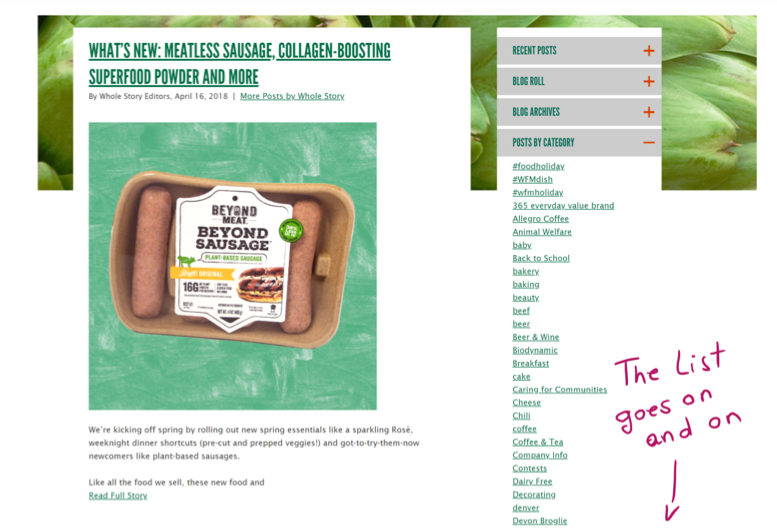
Also, look at this from the point of view of your own internal editorial management. If every category is a sort of bucket of articles, how easily can you fill each one with content over time?
Having fewer categories with a good number of articles created with regular frequency will mean fewer but richer category pages. This is better than creating additional categories – perhaps even with good keyword labels – that require unsustainable rhythms in content production.
There is a somewhat similar tendency in over-tagging blogpost articles. Obviously if your blogging activity is particularly prolific and broad in the range of topics, the number of tags is likely to grow over time.
Although it might seem a user-friendly decision to add as many terms as possible to contextualise what the post is about, this approach tends to be challenged in SEO.
When answering a specific question on how tags should be used, Matt Cutts says there is really not much value in these as Google is able to understand the topic of a content piece without their support. He also says that he, personally, does not use tags on his own blog.
If you look around, you might in fact notice how well optimised sites often do not adopt any tagging system for their content, aside from the main categorisation of posts.
In a way, it is debatable whether tags should be used at all.
However, if tags are present on the blog, one thing that should be especially regarded, rather than the number of tags created, is a more rigorous control and management of those.
Be particularly careful in consistency across labels and conventions: do not create too many tags using synonyms or singular and plural variations. All you are doing, otherwise, is pumping a disorganised cloud of tags which will only result in low value content for crawling and indexing.
So, if there is a question for tag pages to not be valuable for SEO, this brings us to the next point:
Should categories and/or tags be de-indexed?
Let’s first look at tags this time.
We mentioned tag pages tend to have a minor function for SEO. In fact, any person who will have observed search results and web analytics data for a while will have noticed that tag URLs rarely show up as high-ranking pages or strong traffic drivers.
After all, one of the distinctive nature of tags is to function as an internal navigation system. For that alone, one could think Google does not recognise these to be good landing pages for search.
So, if there is a belief that tags are confusing and ultimately only add noise to the index, choosing to no-index these pages can only be a rational decision most of the time.
However, is it fair to apply this rule blankly?
If we look at some real examples, we can easily find cases where, contrary to this view, tag pages do get some visibility and, potentially, traffic.
Here we have some search metrics of the top pages from The Fix, the blog subdomain on the Boohoo website:
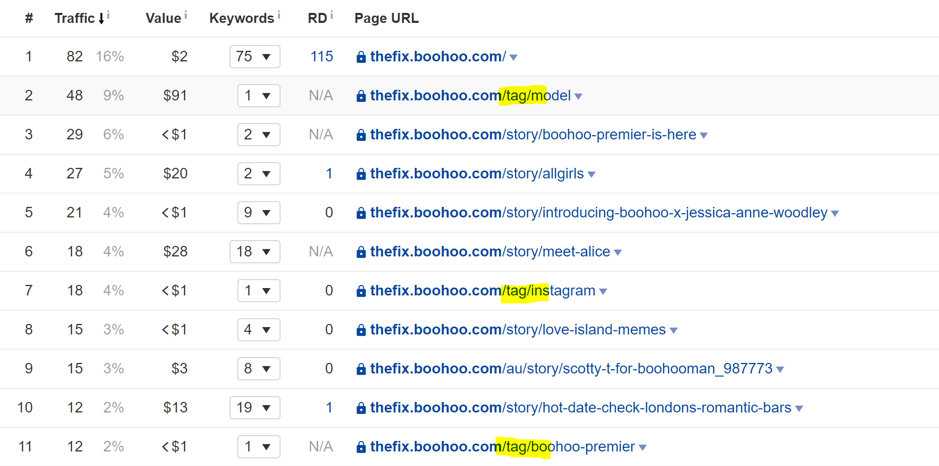
The second most important page of the blog is a tag URL.
In a way, this is not that surprising; tags are content labels, so they will naturally tend to match keywords.
[Case Study] Increase crawl budget on strategic pages
And what about categories?
When it comes to commercial sites, category pages are key to SEO and need to be optimised much more carefully than individual product pages if you aim to rank for generic and high competition keywords.
But is it the same for blog categories?
Given the content rich nature of an article, individual blogposts are much more instrumental as traffic generators, with higher opportunity to target long tail keywords.
But if we agree that blog categories are relatively less important, can there even be a case where these are more of a liability rather than an asset for search?
The problem can in fact arise when blog categories don’t only have a seamless organisational function but create redundant content.
A common scenario especially occurs on retail sites with several product ranges. When it comes to the company blog, it may seem like a logical decision to organise the menu navigation with a similar categorisation to that of the main site.
On the one hand, we’ll have the categories classifying the product pages. On the other hand, will be the blog categories grouping all informative articles about those same products.
This is more or less how Furniture Village does it; the main menu obviously contains the furniture product categories such as living room, dining room and bedroom:
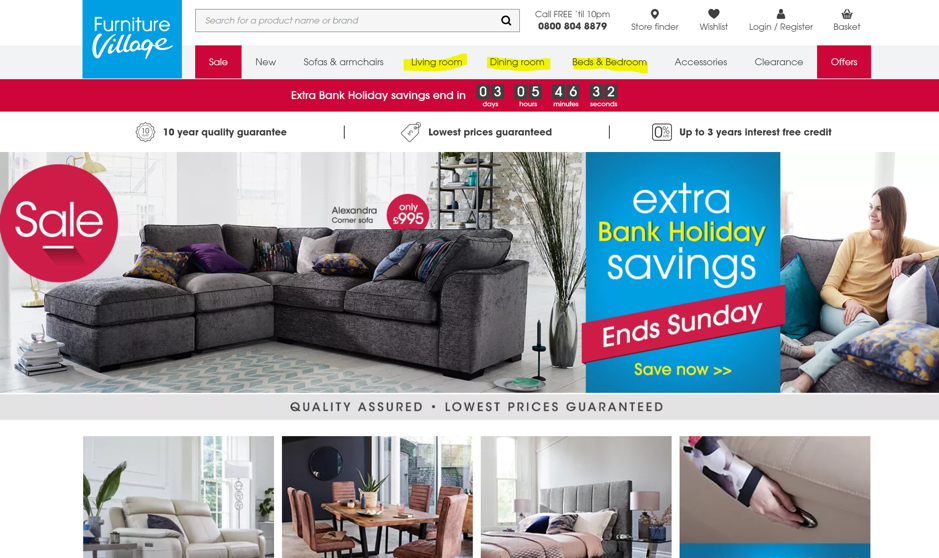
And those same categories are used to group the articles of the editorial section:
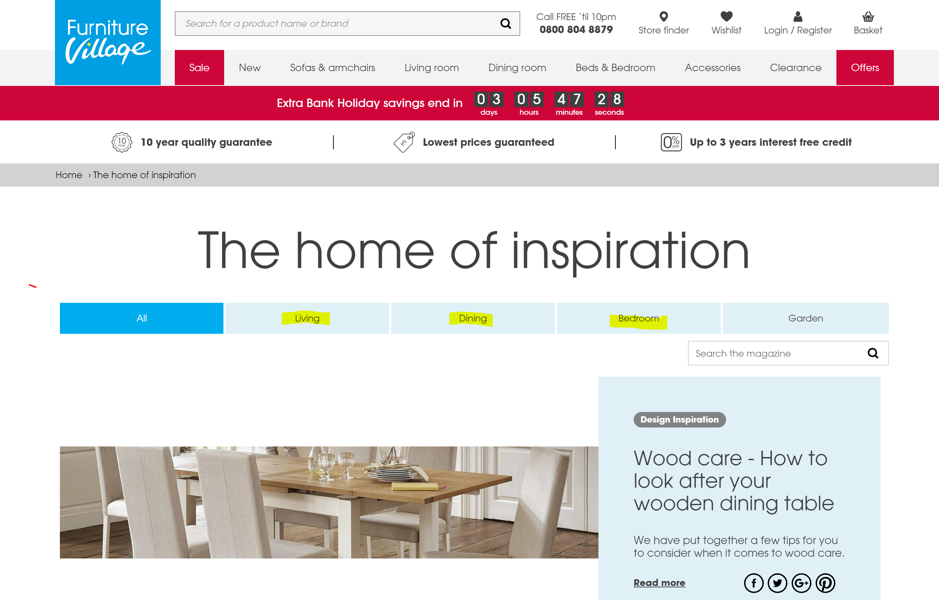
The end result, however, is a high risk of cannibalization between category pages, which is something we definitely need to handle.
Every time we have to deal with duplicate or cannibalising content, two options will generally appear: to cut out or to improve the page content for indexation. Adding a no-index tag would mean cutting out low value content. But blog categories are not low value content by definition; they just happen to be redundant in this case.
So, the second approach may be more suitable and can be done simply by making sure category pages are different from any other page of the site. Aside from making a page distinctive in its layout, content and tagging, the most effective way to do this is to give unique names to blog categories and avoid using similar labels.
Just to stay in the same industry, we can see how this is done on the Habitat blog, using a completely different logic in the top menu:

So, this brings us to the final and most fundamental question:
How to label blog categories and tags?
We previously highlighted how important category pages normally are for search. Most of the keyword research is ultimately done to ensure these can be labelled correctly using profitable keywords.
The category names of a blog may not have the same fundamental role given the informational nature which makes this content less relevant to ‘money’ keywords.
Nonetheless, these pages can still target valuable keywords and for this reason should also be conceived in keyword terms.
It is not uncommon for blog sections to rank for generic and high volume searches.
See, for example, how the Puregym blog category is ranking in top 10 for a purely informational query such as fitness blog:
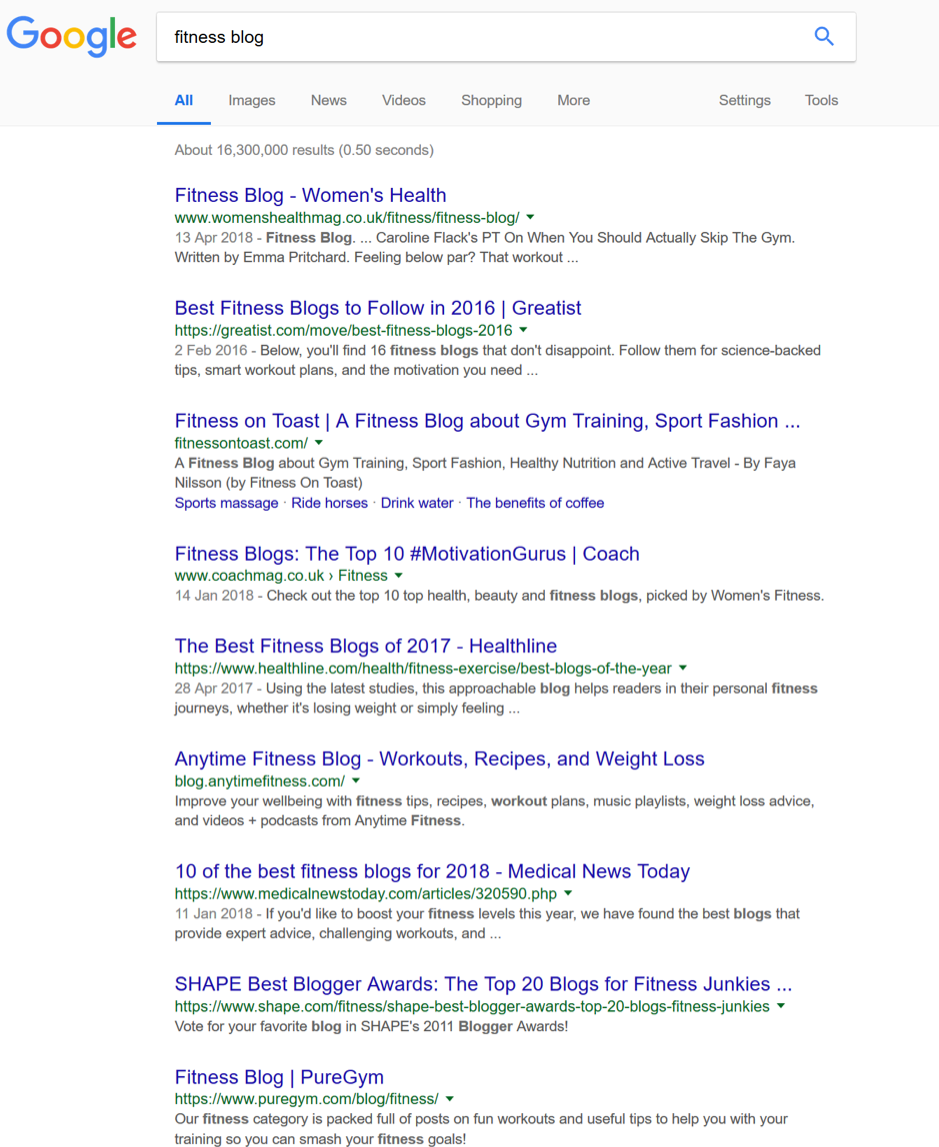
Puregym is pretty much the only commercial brand ranking amongst mostly informative resources. Isn’t that a great sign of high authority when a blog is treated as a proper magazine and a brand gets associated with a generic term?
Blog category pages may not necessarily need the same careful keyword selection to be optimised, yet their names still need to have a certain level of relevancy to the core terms, so do not forget the SEO basics here: name categories after keywords where possible.
In summary, there is not a one size fits all solution when it comes to an optimal blog structure. The usage you decide to make on category and tag pages can help for you blog to contribute to your SEO rather than being completely separate and disconnected from the rest of your strategy.
If a blog is structured like a proper publishing resource, with topics being organised and explicitly labelled, chances of being treated just as an online magazine will be higher.


Hi Valeria:
I am optimizing the backend of an ecommerce site for a customer. I found the topic tag links on the backend and opened them up. These topic tags have an area for SEO. Should I go ahead and fill out the meta information for these topic tags?
Hi Lorena,
It will depend on a lot of things (the website, the tags, the CRM/platform you’re using, the keyword strategy…), but if the tags match keywords the ecommerce site is trying to rank for, it’s generally a good idea to make sure that the topic tag pages are as SEO-friendly as you can reasonably make them. So, yes: go ahead and fill out the meta description and title information for tags if you’re interested in using tag pages to rank for your site.